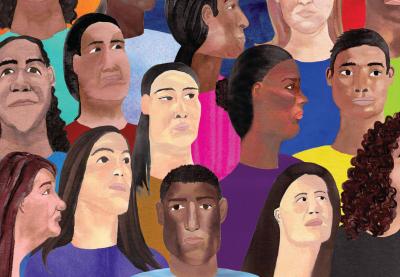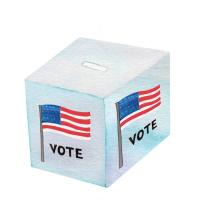Nicole Willis traces her inspiration to enter politics back to one galvanizing experience in high school. She was in government class, just before the 2000 presidential election, when the teacher administered an online quiz about political leaning. Willis was the only one of her Atlanta, Georgia, classmates whose results favored Al Gore instead of George W. Bush.
“I learned very quickly how deeply those thoughts ran in the region that I was in, and to keep my mouth shut,” says Willis, who is—to her knowledge—the only American Indian to have been employed by two presidential campaigns. “I probably never would have gotten involved in politics had that experience not have happened, had I not felt so singled out for having a progressive view.”
Willis, a member of the Umatilla tribe, learned to channel those dissenting views into action. She went on to help Barack Obama make important inroads with the Native community as his First Americans Vote deputy director during his 2008 presidential campaign. She did the same for U.S. Senator Bernie Sanders as the national tribal outreach director during his recent White House run, arranging a record number of meetings with tribal leaders and earning him accolades as a truly Native-friendly candidate.
“The Sanders team was just on the money,” says Mark Trahant, an independent journalist and professor of journalism at the University of North Dakota, whose blog, Trahant Reports, chronicles Native voting across the country. “They had a [Native] person on staff who was identifiable, who had access, who everybody knew.”
Willis’ visibility in presidential politics is relatively rare. American Indians are one of the most underrepresented groups in politics, and they vote at a lower rate than any other demographic in state and national elections.
But that doesn’t mean American Indians don’t vote.
“It is not unheard of for tribal elections to pull 60 to 80 percent of voters, but it is unheard of for national and state elections to pull 30 percent of Indian voters,” says Dean Chavers, co-chair of First Americans for Hillary and director of Catching the Dream, an organization that offers scholarships to Native students. Chavers, a Lumbee Indian from New Mexico, has written books and dozens of articles on Native education and voting-rights issues. “Basically, we’re looking at about a 15 percent voter-registration rate in Indian country,” he says. “It has not changed in the last 50 years. So that’s a big problem.”
Native American or American Indian?
People who are indigenous to the land that is now the United States use both terms, but not everyone is comfortable with both. Teaching Tolerance recognizes the limitations of these identifiers. We use tribal names whenever possible, but—when writing more generally—have opted to use the noun American Indian and the modifier Native based on the recommendations of our advisors who identify as members of this diverse group.
Chavers believes strongly that Native voters face some of the staunchest barriers to voting of any demographic group. When you consider arcane voter-ID laws, language barriers, early voting limitations, redistricting, a lack of outreach and education, and even well-documented cases of outright voter intimidation and suppression, it’s hard to argue with that assessment. “There are all kinds of mechanisms in place to keep the Indian vote down, and it’s working,” Chavers says. “South Dakota, Montana, Oklahoma, New Mexico, Arizona, Nevada, Wyoming, Minnesota—all those states are very anti-Indian in terms of voting, so they won’t let roving registrars [mobile registration units] … go and register Indians.”
This means some reservation residents have to drive an hour or longer to register, and success is not guaranteed. One issue is that reservations often don’t use traditional street addresses, which can cause problems with voter-registration databases. “Your address isn’t 123 Southern Road, Highway 85. It’s ‘one mile past mile marker three,’” explains Patty Ferguson-Bohnee, director of the Indian Legal Program at Arizona State University (ASU). “In the last presidential election we had a lot of problems in Pinal County, where they were turning people away because they said their IDs didn’t match.”
Good News for Native Voters in North Dakota!
As of August 2016, a strict voter ID law was struck down for placing an "undue burden" on American Indians, who make up 25 percent of the state’s electorate.
Ferguson-Bohnee also serves as the Native Vote Election Protection coordinator for the state of Arizona, training lawyers and law students at ASU to help Native voters navigate the red tape and ensure their rights aren’t being violated. Legal challenges to Native voter suppression have been on the rise in recent years, with lawsuits popping up in Alaska, North Dakota, South Dakota and Arizona, among other states. Many of these legal actions were driven by a 2013 U.S. Supreme Court ruling that invalidated the section of the Voting Rights Act of 1965 that provided federal oversight in districts with histories of voter suppression. The weakening of the Act disproportionately affected Native voters.
With a 5.3 percent Native population and 22 different tribes, Arizona is a key state of focus for Native Vote, a nonpartisan campaign spearheaded by the National Congress of American Indians. Native Vote works with local coordinators, educators and lawyers like Ferguson-Bohnee to maximize Native attendance at the polls. The organizers at Native Vote recognize that the 18–24 age group is key in achieving political shifts that benefit American Indians. They’re focusing their social media presence and campus volunteer efforts on American Indian youth and young adults, groups that are more likely to engage in national politics than their parents’ generation.
Glennas’ba Augborne is a Navajo Indian and a 2016 graduate of the Sandra Day O’Connor School of Law at ASU. A volunteer during Arizona’s 2014 midterm elections, Augborne says she became interested in voter law and outreach because of her mother’s strong anti-voting stance. She attributes her mother’s unwillingness to engage in mainstream politics to two things: one, growing up after the boarding school era, during which many Indian children attended government schools that forcibly assimilated them to European-American culture; and two, a long, painful national history of American Indians being denied basic civil rights. “I wanted my mother to vote, but seeing her be so against it definitely struck something within me,” Augborne says. “It made me want to engage others, on and off the reservation, to understand that this is a right we need to engage in; and however we need to do that, we need act so we count.”
"But I Don't Teach Native Students..."
Voting and civic engagement are central to social studies instruction. To tell a complete story about voting in the United States, educators must teach about who got the vote and when, as well as obstacles to voting, both historical and current. As the last group to gain voting rights and as a population still fighting for full enfranchisement, American Indians must be included as part of this instruction.
It’s a sad irony that the country’s first inhabitants were the last to be afforded the right to vote. But Augborne sees the legacy of governmental oppression that infuriates older generations as fuel for civic engagement.
“We’re considered wards of the United States to this day. We are separate sovereigns; we have quote-unquote ‘benefits.’ However, a lot of that is dictated by the laws and regulations mandated ‘for us’ by the federal government,” she says. “Native people should become more involved, in this election now more than ever. We have an obligation to make sure our voices are heard.”
If home isn’t where these conversations are taking place, they need to happen in the classroom, as was the case for Willis. For educators who work with Native students, this means planning explicit instruction about voting rights and the power of voting; staying informed and offering education about ballot initiatives and candidate platforms relevant to Native voters; engaging tribal leaders in civic education efforts; networking with Native Vote and other organizations; and offering school-based voter registration.
"We have a dearth of voters who really understand how voting works and how elections work," says Willis, "so that's something that's certainly important for everybody to learn, because we need more voters. I could see how, in some racially charged locations, it might be more difficult to speak out, but I also think it's something that's hugely motivating to young people because young people, more than anyone, understand that diversity is a value and something that should be celebrated and embraced."
Native Votes Change Outcomes
Thanks to a combination of shifting demographics, strong outreach, education efforts, and key stakeholders at state and national levels, American Indians are in a better position than ever to shape the modern political landscape. Native youth are one of the fastest-growing minority-youth demographics in the nation. And, despite a history of voter suppression and resistance to voting based on mistreatment, American Indians are already deciding elections in certain states.
One of these states is Alaska, where the Native population is close to 15 percent (as opposed to approximately 2 percent of the total U.S. population). In 2010, Lisa Murkowski ran a successful write-in campaign to recapture her U.S. Senate seat, a success many writers who covered the election attribute to the state’s Native voters.
In 2006, U.S. Senator Jon Tester of Montana won his Senate seat over the incumbent by fewer than 4,000 votes, a victory firmly decided by the 17,000 Native votes that went his way. Tester was re-elected in 2012, the same year Native voters in North Dakota sent Heidi Heitkamp to the U.S. Senate with just a 3,000-vote margin of victory. Similar wins are being recorded across the country.
Kris Beecher is a Native Vote volunteer and law student at the Arizona State University Sandra Day O'Connor College of Law. During the 2014 midterm elections, Beecher worked as an election observer. He saw firsthand the influence of Native voters in the re-election of Ann Kirkpatrick, a representative for Arizona’s First Congressional District. The approximately 10,000-vote margin by which Kirkpatrick won re-election in 2014, Beecher says, came courtesy of the Navajo Nation. Kirkpatrick went on to challenge John McCain for his U.S. Senate seat in 2016.
“The Native American vote in this congressional district is so powerful that we are able to influence who we're sending to Congress for a good portion of northern Arizona,” he says. “That should say something as far as the influence that potentially we could have. The more people we register to vote, the more power we have to send certain people to Congress who represent our interests.” Beecher’s takeaway is a common refrain for activists and educators fighting political apathy: “Don’t listen to the people [who] say, ‘Oh your vote doesn’t count.’ It’s hugely important.”



